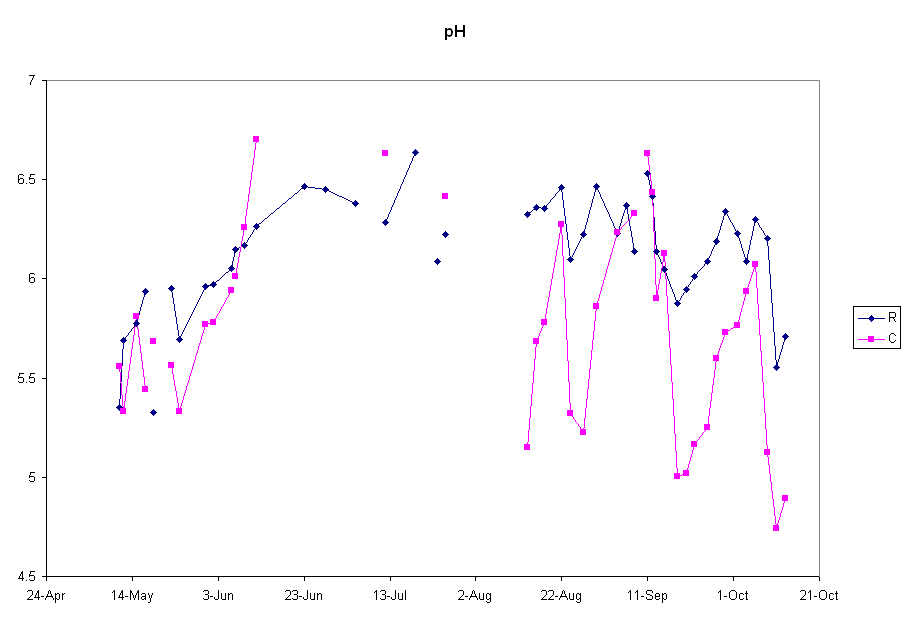

Preliminary Data Summer 2000
(please note this data is still under analysis)
The site:
Bois-des- Bel is an 11.5 ha vacuum harvested peatland that was abandoned in 1980. It is located near Rivière-du-Loup, Quebec. A large portion was restored ( yellow) in the fall of 1999 and some was left in the original condition ( red).


DOC concentration:
Water samples were taken at the outflows of the two sites. Samples were filtered through a 45 mm filter and analyzed for carbon content using a Dorman Total Carbon Analyzer. The results can be seen in fig.1.

fig.1. DOC concentration at the Restored (R) and Comparison (C) sites.
The concentrations measured at this site were much higher than those measured in a natural peatland. Waddington & Roulet (1997) measured concentrations of 20-30 mg/L and Scott & Jones(1998) measured 5-20 mg/L in natural peatlands.
DOC fractions:
DOC was characterized using the method described by Bourbonniere (1989). This involves the separation first according to solubility in acid (reducing the pH to 2), which separates humic and fulvic acids. Then the fulvics are further separated according to their hydrophobicity using XAD8 resin into hydrophobic acids (HPI) and hydrophilic acids (HPO).

a. DOC fractions at the Restored site.

b. DOC fractions at the Comparison Site
Fig.2. Seasonal trends in DOC quality at the two sites
From fig.2, it can be seen that there are clear seasonal trends in the different fractions isolated. HPI (blue) decreases during the early summer, possibly due to increased microbial activity, since this fraction is highly labile and easily degraded. HA (green), which comes from the highly degraded and old peat in the peatland, changes with water content. It is a lower portion when discharge is high, mainly because water flow is on the surface and not deep in the peat-layer. It is higher in proportion when the main discharge comes from base flow. HPO ( red) does not change much during the season since this is the fraction that is most hydrophobic and least likely to be degraded or transported in water.
Factors Controlling DOC:
pH:
DOC is an important contributor to acidity in natural waters. pH fluctuated significantly at the two sites, more noticeably at the comparison site (fig.3) .

fig.3 pH variation at the two sites.
A relationship between the different fractions of DOC and pH was not significant. This indicates that there are other factors affecting the pH of the outflow (fig.4). Base cations could account for this difference ( samples are yet to be analyzed)

fig.4 No significant correlation could be found with pH
Temperature:
Temperature affects the microbial activity; therefore a relationship should be observed between DOC release and air temperature. Although the DOC concentration seems to follow temperature, the relationship is not significant enough to establish this connection (fig.5).

fig.5 DOC concentrations seem to follow temperature but no significant correlation could be found to explain this trend.
Soil Moisture:

fig.6 Significant relationships were observed for DOC loads and the soil moisture index at the Restored site.
The relationship was most significant for HPI, which is expected since this is the most hydrophilic portion of all the fractions. Thus, the wetter the peat is the more easily is this fraction released from the peatland.